Martin R. Oswald
MCGS-SLAM: A Multi-Camera SLAM Framework Using Gaussian Splatting for High-Fidelity Mapping
Sep 17, 2025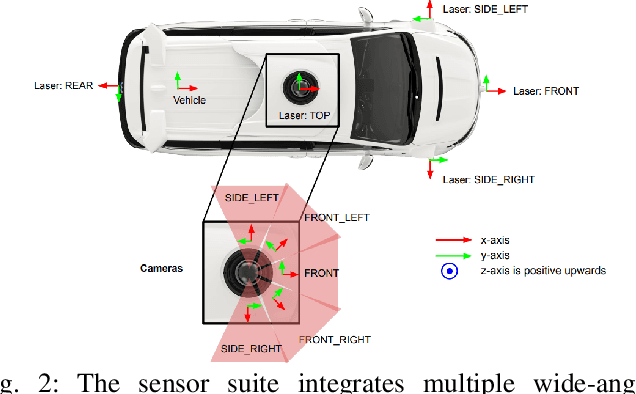
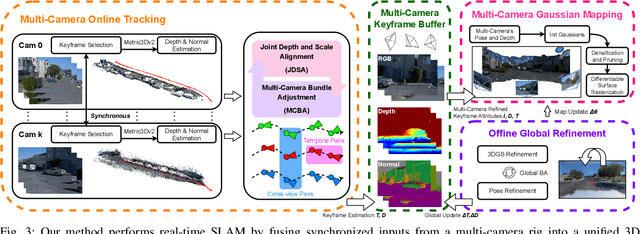
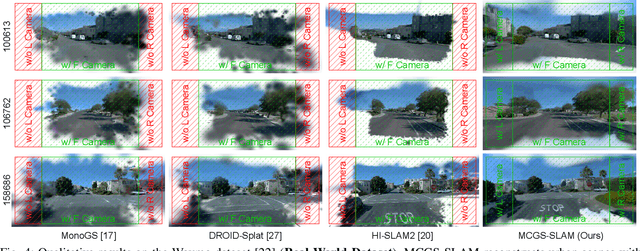
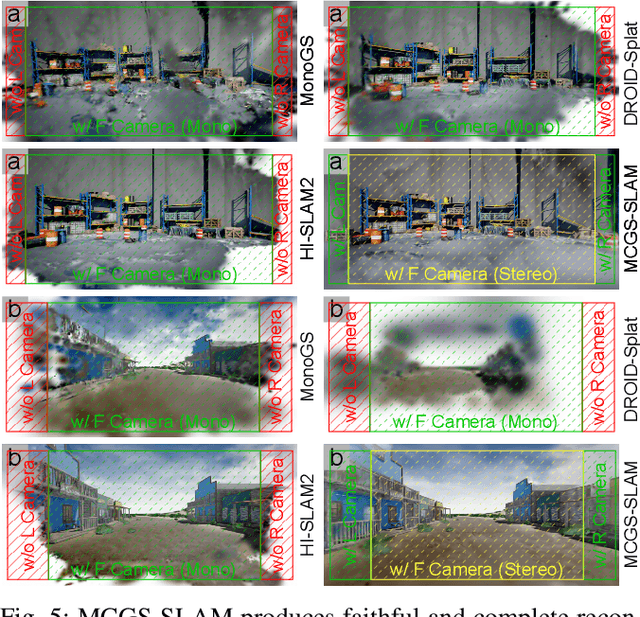
Abstract:Recent progress in dense SLAM has primarily targeted monocular setups, often at the expense of robustness and geometric coverage. We present MCGS-SLAM, the first purely RGB-based multi-camera SLAM system built on 3D Gaussian Splatting (3DGS). Unlike prior methods relying on sparse maps or inertial data, MCGS-SLAM fuses dense RGB inputs from multiple viewpoints into a unified, continuously optimized Gaussian map. A multi-camera bundle adjustment (MCBA) jointly refines poses and depths via dense photometric and geometric residuals, while a scale consistency module enforces metric alignment across views using low-rank priors. The system supports RGB input and maintains real-time performance at large scale. Experiments on synthetic and real-world datasets show that MCGS-SLAM consistently yields accurate trajectories and photorealistic reconstructions, usually outperforming monocular baselines. Notably, the wide field of view from multi-camera input enables reconstruction of side-view regions that monocular setups miss, critical for safe autonomous operation. These results highlight the promise of multi-camera Gaussian Splatting SLAM for high-fidelity mapping in robotics and autonomous driving.
SceneSplat++: A Large Dataset and Comprehensive Benchmark for Language Gaussian Splatting
Jun 10, 2025Abstract:3D Gaussian Splatting (3DGS) serves as a highly performant and efficient encoding of scene geometry, appearance, and semantics. Moreover, grounding language in 3D scenes has proven to be an effective strategy for 3D scene understanding. Current Language Gaussian Splatting line of work fall into three main groups: (i) per-scene optimization-based, (ii) per-scene optimization-free, and (iii) generalizable approach. However, most of them are evaluated only on rendered 2D views of a handful of scenes and viewpoints close to the training views, limiting ability and insight into holistic 3D understanding. To address this gap, we propose the first large-scale benchmark that systematically assesses these three groups of methods directly in 3D space, evaluating on 1060 scenes across three indoor datasets and one outdoor dataset. Benchmark results demonstrate a clear advantage of the generalizable paradigm, particularly in relaxing the scene-specific limitation, enabling fast feed-forward inference on novel scenes, and achieving superior segmentation performance. We further introduce GaussianWorld-49K a carefully curated 3DGS dataset comprising around 49K diverse indoor and outdoor scenes obtained from multiple sources, with which we demonstrate the generalizable approach could harness strong data priors. Our codes, benchmark, and datasets will be made public to accelerate research in generalizable 3DGS scene understanding.
Gaussian Mapping for Evolving Scenes
Jun 07, 2025Abstract:Mapping systems with novel view synthesis (NVS) capabilities are widely used in computer vision, with augmented reality, robotics, and autonomous driving applications. Most notably, 3D Gaussian Splatting-based systems show high NVS performance; however, many current approaches are limited to static scenes. While recent works have started addressing short-term dynamics (motion within the view of the camera), long-term dynamics (the scene evolving through changes out of view) remain less explored. To overcome this limitation, we introduce a dynamic scene adaptation mechanism that continuously updates the 3D representation to reflect the latest changes. In addition, since maintaining geometric and semantic consistency remains challenging due to stale observations disrupting the reconstruction process, we propose a novel keyframe management mechanism that discards outdated observations while preserving as much information as possible. We evaluate Gaussian Mapping for Evolving Scenes (GaME) on both synthetic and real-world datasets and find it to be more accurate than the state of the art.
ToF-Splatting: Dense SLAM using Sparse Time-of-Flight Depth and Multi-Frame Integration
Apr 23, 2025Abstract:Time-of-Flight (ToF) sensors provide efficient active depth sensing at relatively low power budgets; among such designs, only very sparse measurements from low-resolution sensors are considered to meet the increasingly limited power constraints of mobile and AR/VR devices. However, such extreme sparsity levels limit the seamless usage of ToF depth in SLAM. In this work, we propose ToF-Splatting, the first 3D Gaussian Splatting-based SLAM pipeline tailored for using effectively very sparse ToF input data. Our approach improves upon the state of the art by introducing a multi-frame integration module, which produces dense depth maps by merging cues from extremely sparse ToF depth, monocular color, and multi-view geometry. Extensive experiments on both synthetic and real sparse ToF datasets demonstrate the viability of our approach, as it achieves state-of-the-art tracking and mapping performances on reference datasets.
ODHSR: Online Dense 3D Reconstruction of Humans and Scenes from Monocular Videos
Apr 18, 2025Abstract:Creating a photorealistic scene and human reconstruction from a single monocular in-the-wild video figures prominently in the perception of a human-centric 3D world. Recent neural rendering advances have enabled holistic human-scene reconstruction but require pre-calibrated camera and human poses, and days of training time. In this work, we introduce a novel unified framework that simultaneously performs camera tracking, human pose estimation and human-scene reconstruction in an online fashion. 3D Gaussian Splatting is utilized to learn Gaussian primitives for humans and scenes efficiently, and reconstruction-based camera tracking and human pose estimation modules are designed to enable holistic understanding and effective disentanglement of pose and appearance. Specifically, we design a human deformation module to reconstruct the details and enhance generalizability to out-of-distribution poses faithfully. Aiming to learn the spatial correlation between human and scene accurately, we introduce occlusion-aware human silhouette rendering and monocular geometric priors, which further improve reconstruction quality. Experiments on the EMDB and NeuMan datasets demonstrate superior or on-par performance with existing methods in camera tracking, human pose estimation, novel view synthesis and runtime. Our project page is at https://eth-ait.github.io/ODHSR.
3D Gaussian Inverse Rendering with Approximated Global Illumination
Apr 02, 2025Abstract:3D Gaussian Splatting shows great potential in reconstructing photo-realistic 3D scenes. However, these methods typically bake illumination into their representations, limiting their use for physically-based rendering and scene editing. Although recent inverse rendering approaches aim to decompose scenes into material and lighting components, they often rely on simplifying assumptions that fail when editing. We present a novel approach that enables efficient global illumination for 3D Gaussians Splatting through screen-space ray tracing. Our key insight is that a substantial amount of indirect light can be traced back to surfaces visible within the current view frustum. Leveraging this observation, we augment the direct shading computed by 3D Gaussians with Monte-Carlo screen-space ray-tracing to capture one-bounce indirect illumination. In this way, our method enables realistic global illumination without sacrificing the computational efficiency and editability benefits of 3D Gaussians. Through experiments, we show that the screen-space approximation we utilize allows for indirect illumination and supports real-time rendering and editing. Code, data, and models will be made available at our project page: https://wuzirui.github.io/gs-ssr.
Deblur Gaussian Splatting SLAM
Mar 16, 2025Abstract:We present Deblur-SLAM, a robust RGB SLAM pipeline designed to recover sharp reconstructions from motion-blurred inputs. The proposed method bridges the strengths of both frame-to-frame and frame-to-model approaches to model sub-frame camera trajectories that lead to high-fidelity reconstructions in motion-blurred settings. Moreover, our pipeline incorporates techniques such as online loop closure and global bundle adjustment to achieve a dense and precise global trajectory. We model the physical image formation process of motion-blurred images and minimize the error between the observed blurry images and rendered blurry images obtained by averaging sharp virtual sub-frame images. Additionally, by utilizing a monocular depth estimator alongside the online deformation of Gaussians, we ensure precise mapping and enhanced image deblurring. The proposed SLAM pipeline integrates all these components to improve the results. We achieve state-of-the-art results for sharp map estimation and sub-frame trajectory recovery both on synthetic and real-world blurry input data.
WorldPose: A World Cup Dataset for Global 3D Human Pose Estimation
Jan 06, 2025Abstract:We present WorldPose, a novel dataset for advancing research in multi-person global pose estimation in the wild, featuring footage from the 2022 FIFA World Cup. While previous datasets have primarily focused on local poses, often limited to a single person or in constrained, indoor settings, the infrastructure deployed for this sporting event allows access to multiple fixed and moving cameras in different stadiums. We exploit the static multi-view setup of HD cameras to recover the 3D player poses and motions with unprecedented accuracy given capture areas of more than 1.75 acres. We then leverage the captured players' motions and field markings to calibrate a moving broadcasting camera. The resulting dataset comprises more than 80 sequences with approx 2.5 million 3D poses and a total traveling distance of over 120 km. Subsequently, we conduct an in-depth analysis of the SOTA methods for global pose estimation. Our experiments demonstrate that WorldPose challenges existing multi-person techniques, supporting the potential for new research in this area and others, such as sports analysis. All pose annotations (in SMPL format), broadcasting camera parameters and footage will be released for academic research purposes.
MAGiC-SLAM: Multi-Agent Gaussian Globally Consistent SLAM
Nov 25, 2024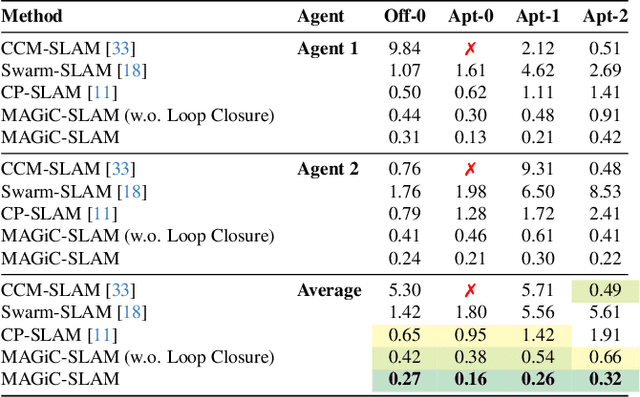

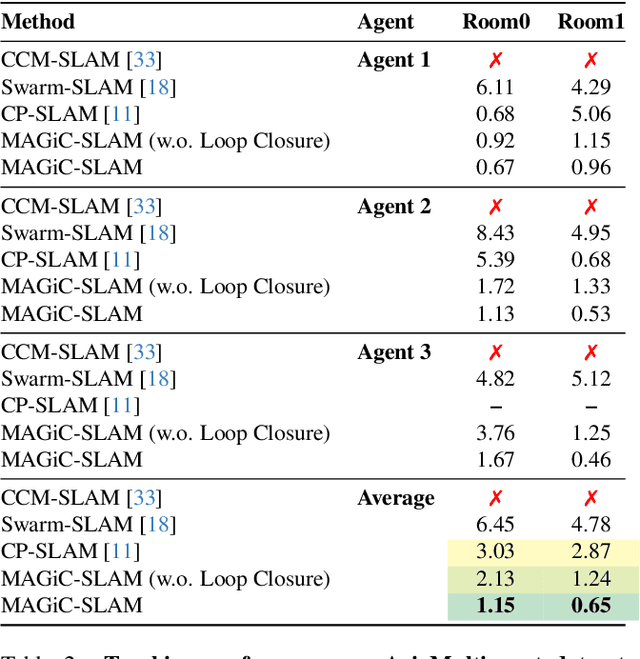
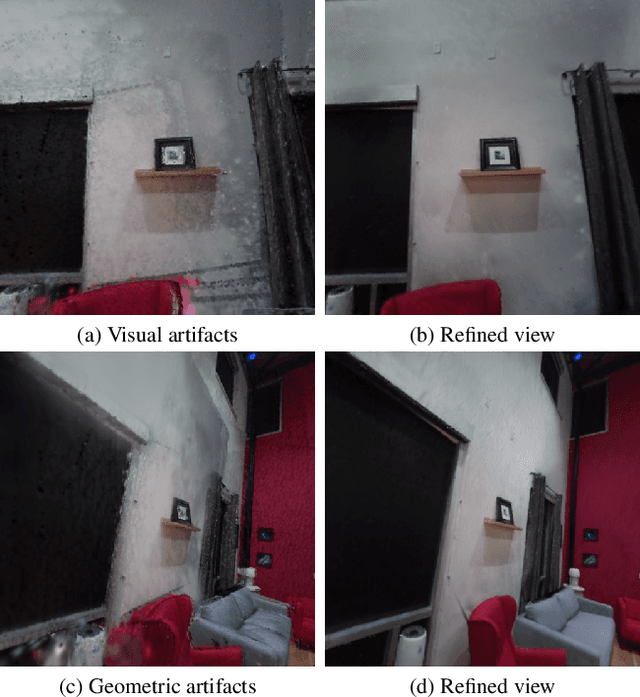
Abstract:Simultaneous localization and mapping (SLAM) systems with novel view synthesis capabilities are widely used in computer vision, with applications in augmented reality, robotics, and autonomous driving. However, existing approaches are limited to single-agent operation. Recent work has addressed this problem using a distributed neural scene representation. Unfortunately, existing methods are slow, cannot accurately render real-world data, are restricted to two agents, and have limited tracking accuracy. In contrast, we propose a rigidly deformable 3D Gaussian-based scene representation that dramatically speeds up the system. However, improving tracking accuracy and reconstructing a globally consistent map from multiple agents remains challenging due to trajectory drift and discrepancies across agents' observations. Therefore, we propose new tracking and map-merging mechanisms and integrate loop closure in the Gaussian-based SLAM pipeline. We evaluate MAGiC-SLAM on synthetic and real-world datasets and find it more accurate and faster than the state of the art.
OVO-SLAM: Open-Vocabulary Online Simultaneous Localization and Mapping
Nov 22, 2024



Abstract:This paper presents the first Open-Vocabulary Online 3D semantic SLAM pipeline, that we denote as OVO-SLAM. Our primary contribution is in the pipeline itself, particularly in the mapping thread. Given a set of posed RGB-D frames, we detect and track 3D segments, which we describe using CLIP vectors, calculated through a novel aggregation from the viewpoints where these 3D segments are observed. Notably, our OVO-SLAM pipeline is not only faster but also achieves better segmentation metrics compared to offline approaches in the literature. Along with superior segmentation performance, we show experimental results of our contributions integrated with Gaussian-SLAM, being the first ones demonstrating end-to-end open-vocabulary online 3D reconstructions without relying on ground-truth camera poses or scene geometry.
 Add to Chrome
Add to Chrome Add to Firefox
Add to Firefox Add to Edge
Add to Edge